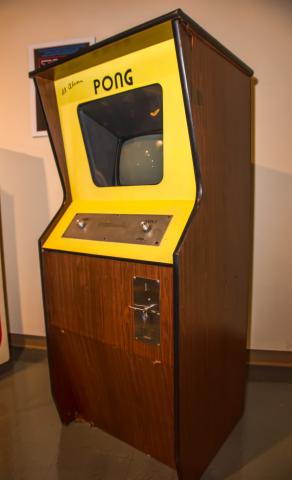Media
Pong Cabinet
Pong Cabinet
Text
Two white paddles sweep across a solid black background, passing a small square ball back and forth across the screen. Inspired by ping-pong, Pong was one of the earliest arcade games, and was the first commercially successful game. Emerging in 1972, Pong set the foundation for the video game industry, which developed parallel to the microcomputer industry.
The first video games were programmed by computer hobbyists, who in the 1960s used simple games for their own entertainment. Semiconductor chips (or microchips), which concentrated computer circuits for increased speed and power, allowed for the creation of computers solely for video games. Pong was released by Atari in 1972 as an arcade game, found mostly in amusement parks and carnivals. Arcade games became remarkably popular, leading to the formation of multiple domestic and foreign competitors for Atari.
When the price of microchips dropped during the mid-1970s, Atari and others began experimenting with consoles that could be connected to television sets. Home consoles became more popular and less expensive during the later 1970s, leading many corporations to release their own video game consoles. This glut of systems led to a crash of the video game market in 1983, which consolidated manufacturers and standardized the consoles themselves.
As the popularity of the microcomputer and the video game grew in the 1980s, the two began overlapping in interesting ways. Atari, which was founded in 1971 as a video game company, released multiple microcomputers during the early 1980s before going belly up in the mid-1980s. Atari also produced educational software for the microcomputer, including the AtariLab modules featured on this website. Many microcomputer manufacturers also started releasing games for their computers, increasing the number of people purchasing units solely for gaming. This overlap of the microcomputer and the video game market continued through the 1980s, with games such as Minesweeper encouraging the use of new computer hardware such as the mouse.
Many corporations believed that the microcomputer would be used primarily for gaming, and tailored their units accordingly. Video games now challenge both television and motion pictures as the leading form of entertainment for Americans. Whether in console or computer format, the video game market survives and thrives thanks to developments in electronics in the 1970s and 1980s.
Image courtesy of Chris Rand via Wikimedia Commons.
For Further Reading:
Campbell-Kelly, Martin, William Aspray, Nathan Ensmenger, and Jeffrey R. Yost. Computer: A History of the Information Machine. Boulder, CO: Westview Press, 2014; Third edition.

